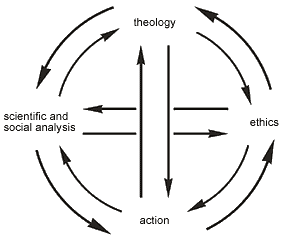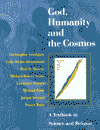Possibilities for DialoguePossibilities for dialogue between science and religion These can be at the level of:
It must be pointed out that today the
hegemony lies with the scientific community. Science is a rational enterprise
of unparallelled success (by its own lights - those of providing understanding
of the physical universe - if not necessarily those of furnishing humans with
wisdom as to how to live). Gerd Theissen claims that ‘Nowadays religion is on
the opposition benches and science forms the government. It would be good if religion
could find a way out of its role as a smouldering opposition, and if science
were less arrogant as the government.’ The Bossey Circle is a World Council of Churches diagram designed to show the interplay between the sciences, theology, ethics, and action.
A
World Council of Churches diagram In practice the Bossey Circle all too often looks like one-way traffic - science sets the parameters for what can be believed about the world, religious doctrines have to fall in line. An example often cited is the doctrine of the Fall, in which science does seem to have restricted the range of what it is appropriate to believe. For some theologians this also extends to considerations about the nature of resurrection and virginal conception (see Peacocke and Polkinghorne compared). In other cases, however, in particular in
respect of the ultimate fate of the universe, it seems essential for theology
to continue to assert hopes to which astrophysics is in no position to give
support.
Email
link | Feedback | Contributed by: Dr. Christopher Southgate
|







